
Rhodometra sacraria, the vestal, is a moth of the family Geometridae. The species was first described by Carl Linnaeus in his 1767 12th edition of Systema Naturae.

Dasychira is a genus of tussock moths in the family Erebidae described by Jacob Hübner in 1809. They are well distributed all over Africa, Europe, North America, Madagascar, Japan, China, India, Sri Lanka, Myanmar, Java and Australia.

Trabala is a genus of moths in the family Lasiocampidae described by Francis Walker in 1856.

Drepanogynis is a genus in the geometer moth family (Geometridae). Long considered to hold about 5 dozen species, this number has been doubled after the last major revision. They are stout-bodied and hairy by geometer moth standards, usually have pale hindwings and rest with their wings angled upwards like a roof, as Nacophorini do. The genus is by and large restricted to Africa south of the Equator, with most species occurring in southern Africa.

Sterrhinae is a large subfamily of geometer moths with some 3,000 described species, with more than half belonging to the taxonomically difficult, very diverse genera, Idaea and Scopula. This subfamily was described by Edward Meyrick in 1892. They are the most diverse in the tropics with the number of species decreasing with increasing latitude and elevation.

Acanthosphinx is a monotypic moth genus in the family Sphingidae erected by Per Olof Christopher Aurivillius in 1891. Its only species, Acanthosphinx guessfeldti, the widow sphinx, was first described by Hermann Dewitz in 1879. It is known from forests from Sierra Leone to the Congo, Angola, Zambia, Malawi, Tanzania and Uganda.

Papilio mechowi is a butterfly of the family Papilionidae found in Africa.

Basiothia medea, the small verdant hawk, is a moth of the family Sphingidae. It is common in open habitats throughout the Ethiopian Region, including Madagascar. It is however probably absent from the equatorial forest belt, except as a vagrant. The species is an active migrant.

Oraesia emarginata is a species of moth of the family Erebidae first described by Johan Christian Fabricius in 1794. It is found in Australia, New Caledonia, Indonesia, New Guinea, Pakistan, the Philippines, India, Sri Lanka, Sulawesi, Taiwan, China, Japan, Korea and Nepal as well as Eritrea, Ethiopia, Kenya, Namibia, Nigeria, South Africa, Tanzania, the Gambia, Uganda, Oman and Yemen.

Thalassodes quadraria is a species of moth of the family Geometridae first described by Achille Guenée in 1857. It is found in Africa south of the Sahara and in India and Sri Lanka.

Eutelia geyeri is a moth of the family Euteliidae first described by Rudolf Felder and Alois Friedrich Rogenhofer in 1874. This species is found in India, Sri Lanka, China and Japan, as well as from Africa, where its presence had been reported from Lesotho and Seychelles.
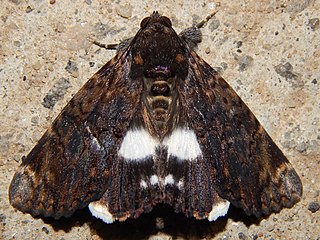
Nagia linteola is a species of moth in the family Erebidae first described by Achille Guenée in 1852. This species occurs in South Africa, the Democratic Republic of the Congo, Yemen, the Comoros, Mauritius, Madagascar, Indonesia (Borneo), India, Sri Lanka, Myanmar, Thailand and in Australia, where it has been recorded from Western Australia, the Northern Territory, Queensland and Victoria.

Drepanogynis curvaria is a species of moth of the family Geometridae first described by Hermann Dewitz in 1881. It is found in South Africa.
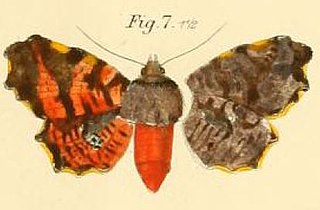
Dysodia is a genus of moths of the family Thyrididae. It was described by James Brackenridge Clemens in 1860.
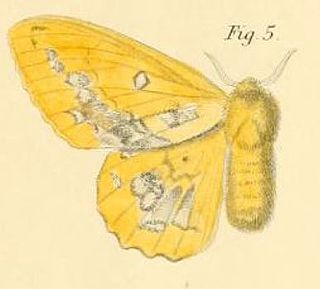
Trabala burchardii is a moth of the family Lasiocampidae. The species was first described by Hermann Dewitz in 1881. It is found in Angola, Cameroon, Equatorial Guinea, Kenya, Nigeria and Ghana.

Pitthea trifasciata is a moth of the family Geometridae first described by Hermann Dewitz in 1881.

Procanthia distantii is a moth in the subfamily Arctiinae. It was described by Hermann Dewitz in 1881. It is found in South Africa.

Bradina sordidalis is a moth in the family Crambidae. It was described by Hermann Dewitz in 1881. It is found in Cameroon, Equatorial Guinea and Nigeria.
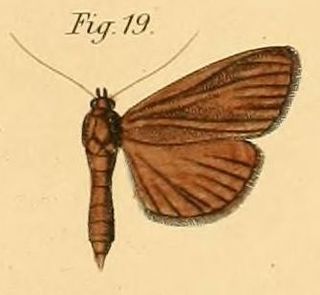
Phostria fumarialis is a species of moth in the family Crambidae. It was described by Hermann Dewitz in 1881. It is found in Angola.
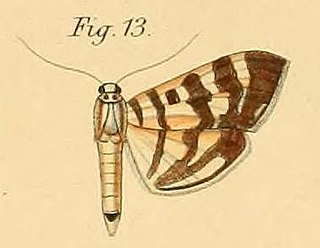
Syllepte butlerii is a moth in the family Crambidae. It was described by Hermann Dewitz in 1881. It is found in Angola, Cameroon, the Democratic Republic of the Congo, Sierra Leone and Zambia.

















